skip to main |
skip to sidebar
I guess I could have called this a vattha kuzhambu except for the fact that I carefully refrained from using manthakkali or chundakkai vatthal (dried berries). This puli kuzhambu tastes very nice, if you ask me. If, however, you DON'T want to ask me, I guess you'll have to make it and discover this fact for yourself, won't you?
Recipe for: Flaxseed puli kuzhambu (tamarind gravy)
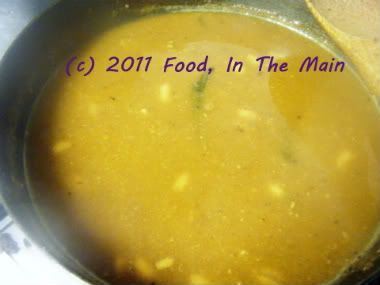 Ingredients:
2 tbsp dry-roasted flaxseeds
1 htbsp sambar powder
2 tsp rice flour
1/4 cup roasted peanuts
Lime-sized amount of tamarind/2 tsp tamarind paste
2 tsp tuvar dal
1 tsp mustard seeds
1/2 tsp vendhayam/fenugreek seeds
5-6 fresh/frozen curry leaves
1 tbsp gingelly oil/nallennai
Salt to taste
4-5 cups water
Method:
1. Pound or grind the flaxseeds to a fine powder.
Ingredients:
2 tbsp dry-roasted flaxseeds
1 htbsp sambar powder
2 tsp rice flour
1/4 cup roasted peanuts
Lime-sized amount of tamarind/2 tsp tamarind paste
2 tsp tuvar dal
1 tsp mustard seeds
1/2 tsp vendhayam/fenugreek seeds
5-6 fresh/frozen curry leaves
1 tbsp gingelly oil/nallennai
Salt to taste
4-5 cups water
Method:
1. Pound or grind the flaxseeds to a fine powder.
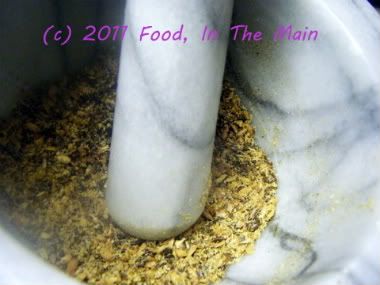 2. Dissolve the tamarind in 4 cups water (or extract the pulp from the dry tamarind). Reserve.
3. Heat the oil in a pan, add the asafoetida powder, tuvar dal, fenugreek seeds, curry leaves, and mustard seeds. Cover and let the seeds pop, let the dal turn golden brown,
2. Dissolve the tamarind in 4 cups water (or extract the pulp from the dry tamarind). Reserve.
3. Heat the oil in a pan, add the asafoetida powder, tuvar dal, fenugreek seeds, curry leaves, and mustard seeds. Cover and let the seeds pop, let the dal turn golden brown,
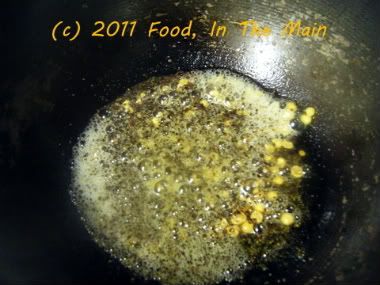 then pour in the tamarind water.
then pour in the tamarind water.
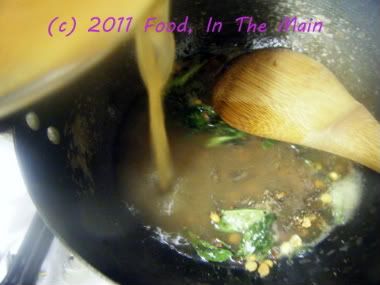 Let this come to a brisk boil.
4. While it is coming up to the boil, mix together the flaxseed powder, sambar powder and rice flour,
Let this come to a brisk boil.
4. While it is coming up to the boil, mix together the flaxseed powder, sambar powder and rice flour,
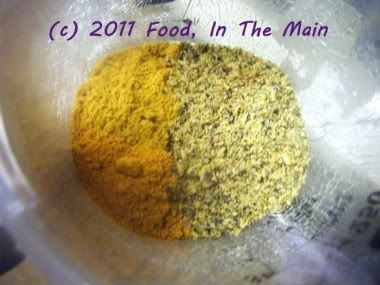 add 1/4 cup water and whisk to a pourable mixture without lumps.
add 1/4 cup water and whisk to a pourable mixture without lumps.
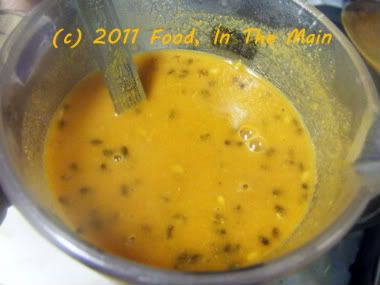 5. Now pour this into the tamarind water and stir it in, along with salt to taste.
5. Now pour this into the tamarind water and stir it in, along with salt to taste.
 6. Keep the heat on medium and let the kuzhambu simmer for 10 minutes to let the flavours come together, and for it to thicken. Then add the peanuts and allow the kuzhambu to boil for 5 minutes more.
6. Keep the heat on medium and let the kuzhambu simmer for 10 minutes to let the flavours come together, and for it to thicken. Then add the peanuts and allow the kuzhambu to boil for 5 minutes more.
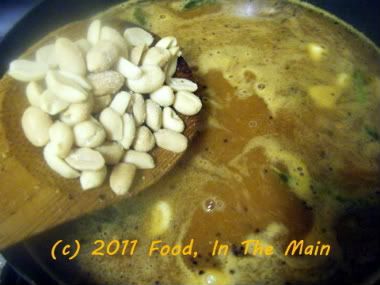 7. The longer the kuzhambu sits, the better it will taste. Reheat before serving, along with steamed rice and any kootu or vegetable curry.
RECIPE: FLAXSEED PEANUT PULI KUZHAMBU (TAMARIND GRAVY)
Ingredients:
2 tbsp dry-roasted flaxseeds
1 htbsp sambar powder
2 tsp rice flour
1/4 cup roasted peanuts
Lime-sized amount of tamarind/2 tsp tamarind paste
2 tsp tuvar dal
1 tsp mustard seeds
1/2 tsp vendhayam/fenugreek seeds
5-6 fresh/frozen curry leaves
1 tbsp gingelly oil/nallennai
Salt to taste
4-5 cups water
Method:
1. Pound or grind the flaxseeds to a fine powder.
2. Dissolve the tamarind in 4 cups water (or extract the pulp from the dry tamarind). Reserve.
3. Heat the oil in a pan, add the asafoetida powder, tuvar dal, fenugreek seeds, curry leaves, and mustard seeds. Cover and let the seeds pop, let the dal turn golden brown, then pour in the tamarind water. Let this come to a brisk boil.
4. While it is coming up to the boil, mix together the flaxseed powder, sambar powder and rice flour, add 1/4 cup water and whisk to a pourable mixture without lumps.
5. Now pour this into the tamarind water and stir it in, along with salt to taste.
6. Keep the heat on medium and let the kuzhambu simmer for 10 minutes to let the flavours come together, and for it to thicken. Then add the peanuts and allow the kuzhambu to boil for 5 minutes more.
7. The longer the kuzhambu sits, the better it will taste. Reheat before serving, along with steamed rice and any kootu or vegetable curry.
7. The longer the kuzhambu sits, the better it will taste. Reheat before serving, along with steamed rice and any kootu or vegetable curry.
RECIPE: FLAXSEED PEANUT PULI KUZHAMBU (TAMARIND GRAVY)
Ingredients:
2 tbsp dry-roasted flaxseeds
1 htbsp sambar powder
2 tsp rice flour
1/4 cup roasted peanuts
Lime-sized amount of tamarind/2 tsp tamarind paste
2 tsp tuvar dal
1 tsp mustard seeds
1/2 tsp vendhayam/fenugreek seeds
5-6 fresh/frozen curry leaves
1 tbsp gingelly oil/nallennai
Salt to taste
4-5 cups water
Method:
1. Pound or grind the flaxseeds to a fine powder.
2. Dissolve the tamarind in 4 cups water (or extract the pulp from the dry tamarind). Reserve.
3. Heat the oil in a pan, add the asafoetida powder, tuvar dal, fenugreek seeds, curry leaves, and mustard seeds. Cover and let the seeds pop, let the dal turn golden brown, then pour in the tamarind water. Let this come to a brisk boil.
4. While it is coming up to the boil, mix together the flaxseed powder, sambar powder and rice flour, add 1/4 cup water and whisk to a pourable mixture without lumps.
5. Now pour this into the tamarind water and stir it in, along with salt to taste.
6. Keep the heat on medium and let the kuzhambu simmer for 10 minutes to let the flavours come together, and for it to thicken. Then add the peanuts and allow the kuzhambu to boil for 5 minutes more.
7. The longer the kuzhambu sits, the better it will taste. Reheat before serving, along with steamed rice and any kootu or vegetable curry.
Happy new year 2011, everybody! My first post of the new year is an eggless cake, using flaxseed powder as a substitute for the egg in the original recipe - and goodness knows where I got that from. Anyway, it works! Flaxseed as a substitute for eggs really does work! There's no reason it SHOULDN'T, because this particular substitution has been recommended and tried by plenty of others. It's just that I needed to try it for myself before I could actually believe it. And I'm pretty sure I don't need to feel lonely in this respect, I'm sure I have plenty of company.
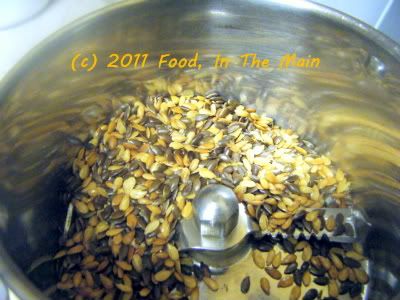 I'd dry roasted a lot of flaxseeds earlier, and it was a simple job to grind one tablespoon of the seeds to powder and mix it with water.
I'd dry roasted a lot of flaxseeds earlier, and it was a simple job to grind one tablespoon of the seeds to powder and mix it with water.
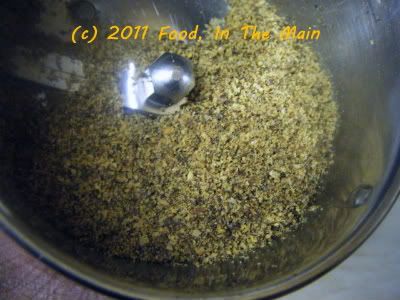 It's one thing to be told that 1 tbsp flaxseed powder + 3 tbsp water = one egg. It's quite another thing to realise that the flaxseed powder simply SUCKS up the water,
It's one thing to be told that 1 tbsp flaxseed powder + 3 tbsp water = one egg. It's quite another thing to realise that the flaxseed powder simply SUCKS up the water,
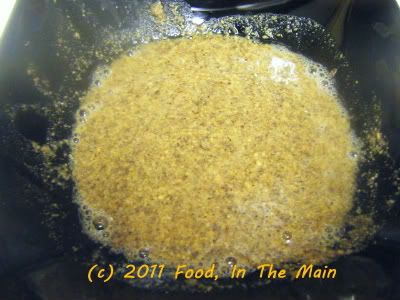 and when the mixture is added to cake batter, it makes the batter really really gooey. In fact, the batter felt so gooey that I wondered if the cake would turn out a disaster, but hooray for flaxseeds, it didn't!
If you look at the photos of the cake, you'll see that the hazelnuts are practically powdered. That was not the effect I was after. I wanted the nuts chopped, not ground to dust. Sadly, one moment's distraction while running the nuts in the grinder is all it takes to pulverise rather than chop - so take note.
In short, if you DO make this cake, be sure to chop the nuts (whichever nuts you may substitute) a bit chunky; they're best not pulverised.
Recipe for: Flaxseed orange cake with hazelnuts
and when the mixture is added to cake batter, it makes the batter really really gooey. In fact, the batter felt so gooey that I wondered if the cake would turn out a disaster, but hooray for flaxseeds, it didn't!
If you look at the photos of the cake, you'll see that the hazelnuts are practically powdered. That was not the effect I was after. I wanted the nuts chopped, not ground to dust. Sadly, one moment's distraction while running the nuts in the grinder is all it takes to pulverise rather than chop - so take note.
In short, if you DO make this cake, be sure to chop the nuts (whichever nuts you may substitute) a bit chunky; they're best not pulverised.
Recipe for: Flaxseed orange cake with hazelnuts
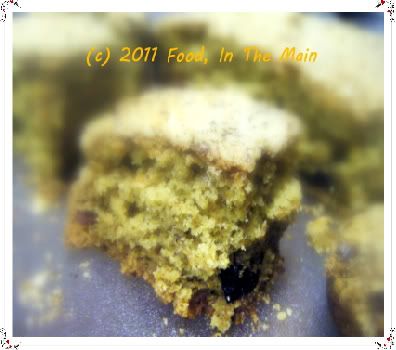 Ingredients:
1/3 cup oil
pinch salt
1 tbsp grated orange rind
1/2 cup sugar
1 tbsp flaxseed powder + 3 tbsp water
1-1/3 cups flour
1/2 teaspoon baking powder
1/2 teaspoon baking soda
1/4 cup cream or yogurt
1/3 cup dried berries
3-4 tbsp milk (if required)
3 tbsp Grand Marnier or Cointreau liqueur (or orange juice)
1/4 cup finely chopped hazelnuts
Method:
1. Preheat oven to 350°C.
2. Mix oil, salt, orange rind, Grand Marnier and sugar in a large bowl.
Ingredients:
1/3 cup oil
pinch salt
1 tbsp grated orange rind
1/2 cup sugar
1 tbsp flaxseed powder + 3 tbsp water
1-1/3 cups flour
1/2 teaspoon baking powder
1/2 teaspoon baking soda
1/4 cup cream or yogurt
1/3 cup dried berries
3-4 tbsp milk (if required)
3 tbsp Grand Marnier or Cointreau liqueur (or orange juice)
1/4 cup finely chopped hazelnuts
Method:
1. Preheat oven to 350°C.
2. Mix oil, salt, orange rind, Grand Marnier and sugar in a large bowl.
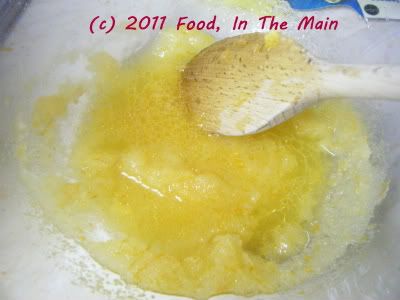 3. Beat in the flaxseed mixture along with the cream or yogurt.
3. Beat in the flaxseed mixture along with the cream or yogurt.
 4. Sift together the flour, baking soda and baking powder. Add to wet mixture in three or four stages, stirring well in between,
4. Sift together the flour, baking soda and baking powder. Add to wet mixture in three or four stages, stirring well in between,
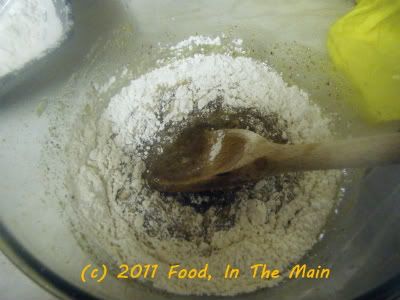 then add the dried berries and mix them in well.
then add the dried berries and mix them in well.
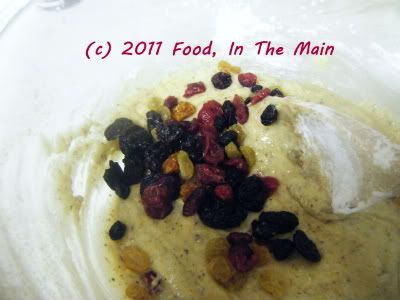 The batter will be quite sticky and gooey. Beat in some milk if the batter feels too thick.
5. Pour the batter into a 7" round or square pan which has been sprayed with Pam.
6. Spread the chopped nuts on the surface, pressing them in gently so that they are partly sunk in the batter.
The batter will be quite sticky and gooey. Beat in some milk if the batter feels too thick.
5. Pour the batter into a 7" round or square pan which has been sprayed with Pam.
6. Spread the chopped nuts on the surface, pressing them in gently so that they are partly sunk in the batter.
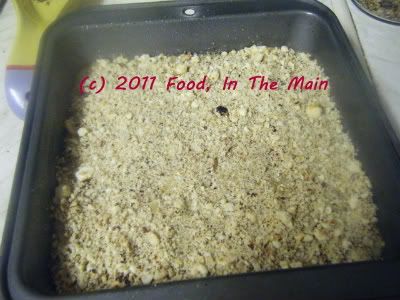 7. Bake till the cake is done - about 45-50 minutes, although it's best to check from 30 minutes onwards, depending on your oven.
7. Bake till the cake is done - about 45-50 minutes, although it's best to check from 30 minutes onwards, depending on your oven.
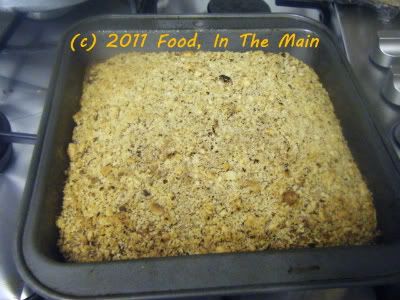 8. Cool the cooked cake for 10 minutes in the pan, then remove to a wire cooling rack to cool completely.
8. Cool the cooked cake for 10 minutes in the pan, then remove to a wire cooling rack to cool completely.
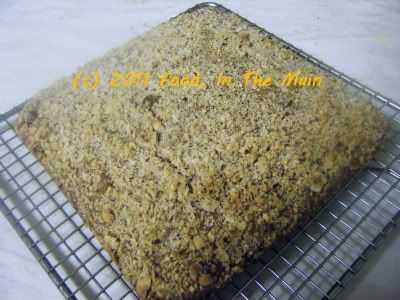 Cut when cool.
Cut when cool.
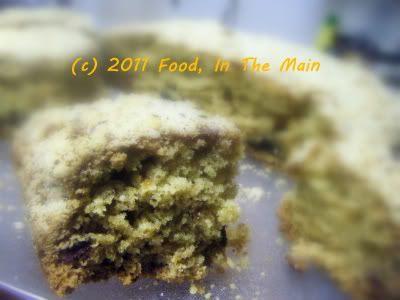 RECIPE: FLAXSEED ORANGE CAKE WITH HAZELNUTS
Ingredients:
1/3 cup oil
pinch salt
1 tbsp grated orange rind
1/2 cup sugar
1 tbsp flaxseed powder + 3 tbsp water
1-1/3 cups flour
1/2 teaspoon baking powder
1/2 teaspoon baking soda
1/4 cup cream or yogurt
1/3 cup dried berries
3-4 tbsp milk (if required)
3 tbsp Grand Marnier or Cointreau liqueur (or orange juice)
1/4 cup finely chopped hazelnuts
Method:
1. Preheat oven to 350°C.
2. Mix oil, salt, orange rind, Grand Marnier and sugar in a large bowl.
3. Beat in the flaxseed mixture along with the cream or yogurt.
4. Sift together the flour, baking soda and baking powder. Add to wet mixture, then add the dried berries and mix them in well. The batter will be a bit sticky and gooey. Beat in some milk if the batter feels too thick.
5. Pour the batter into a 7" round or square pan which has been sprayed with Pam.
6. Spread the chopped nuts on the surface, pressing them in gently so that they are partly sunk in the batter.
7. Bake till the cake is done - about 45-50 minutes, although it's best to check from 30 minutes onwards, depending on your oven.
8. Cool the cooked cake for 10 minutes in the pan, then remove to a wire cooling rack to cool completely.
RECIPE: FLAXSEED ORANGE CAKE WITH HAZELNUTS
Ingredients:
1/3 cup oil
pinch salt
1 tbsp grated orange rind
1/2 cup sugar
1 tbsp flaxseed powder + 3 tbsp water
1-1/3 cups flour
1/2 teaspoon baking powder
1/2 teaspoon baking soda
1/4 cup cream or yogurt
1/3 cup dried berries
3-4 tbsp milk (if required)
3 tbsp Grand Marnier or Cointreau liqueur (or orange juice)
1/4 cup finely chopped hazelnuts
Method:
1. Preheat oven to 350°C.
2. Mix oil, salt, orange rind, Grand Marnier and sugar in a large bowl.
3. Beat in the flaxseed mixture along with the cream or yogurt.
4. Sift together the flour, baking soda and baking powder. Add to wet mixture, then add the dried berries and mix them in well. The batter will be a bit sticky and gooey. Beat in some milk if the batter feels too thick.
5. Pour the batter into a 7" round or square pan which has been sprayed with Pam.
6. Spread the chopped nuts on the surface, pressing them in gently so that they are partly sunk in the batter.
7. Bake till the cake is done - about 45-50 minutes, although it's best to check from 30 minutes onwards, depending on your oven.
8. Cool the cooked cake for 10 minutes in the pan, then remove to a wire cooling rack to cool completely.
Powerhouse muffins - what else could you possibly call muffins that have, as part of the ingredients, peanut butter, mashed banana, fresh pineapple, flaxseed powder, toasted skin-on almonds, raw cauliflower...
Wait, what? Cauliflower? That smelly vegetable? In a sweet muffin? Oh yes, you read that right, people. This muffin recipe actually does have raw cauliflower as an ingredient. If you're like me, you'd be wondering why anybody would want to add cauliflower to a muffin. (If you're not like me and you routinely add inappropriate ingredients to your recipes and make a success of them, what are you doing reading this blog in the first place??? My conservative - in terms of mixing and matching food ingredients - blog will hold no surprises for you!)
But while I might not come up with weird and wonderful food ideas all on my own, I'm still capable of recognising weird and wonderful food ideas when I come across them on other blogs. And, assuming the weirdness and wonderfulness does not seem completely insane to me, I can be intrigued into trying out the weird and the wonderful for myself, just to see if the weird and the wonderful can actually come together and make something edible and tasty.
I really, really didn't think the muffins would turn out well - in the sense that they would appeal to my tastebuds, especially with me knowing about the cauliflower. (I would have preferred to make them without me knowing, to be honest, but I just couldn't bend reality enough. Should have tried harder, maybe...) I was doubtful about the muffins' edibility mainly because I'm not one of those people who eat dreadful-tasting things merely on the dubious grounds that they're "healthy". My healthy has to come strongly disguised as tasty, let me tell you.
Anyway, as I was saying, I was sufficiently taken up with the thought of trying out the muffins on Pete (what, did you think I'D actually eat one first???), so I went ahead and made them, with a couple of minor changes in ingredients and quantities. (The original recipe can be found here.) As it turned out, even if I'd wanted to be the guinea pig, Pete didn't give me the chance. He sneaked one while it was quite hot and still cooling on the countertop, and pronounced them "lovely". To be fair, they smelt really rather nice.
I let him eat the muffin fully and start on another before I said: "The muffins are nice, are they?"
"Oh yeah, really soft and fruity."
"Oh good," I said, happily. "So do you want to know what's in them?"
He regarded me suspiciously, mid-bite. "What? I suppose you're going to say it's something dreadful?"
"Depends on what you'd consider dreadful." I grinned at him. "It's got pureed cauliflower in it!"
He looked at the half-eaten muffin in his hand like it was an apple in which he'd found half a worm.
"Cauliflower?" he repeated in pained disbelief. "What in god's name made you think of making muffins with cauliflower?"
"It was a recipe I saw on a blog," I said. "Obviously it works, because you couldn't taste or smell the cauliflower. Glad you tasted it first, though."
He made a few noises like he was going to be sick, while swallowing the rest of the muffin. "For god's sake, don't sppring this sort of thing on me!" he grumbled.
And then he went back to the kitchen to get himself another muffin.
Recipe for: Powerhouse muffins
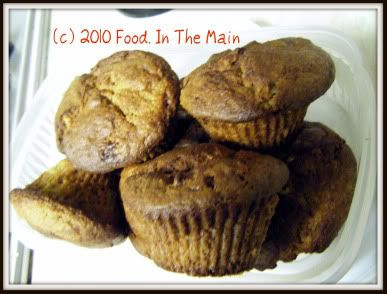
Ingredients:
1/2 (heaped) cup light brown sugar
1/4 cup peanut butter (I used chunky, and I'm glad I didnt use 1/2 cup as I found the peanut butter taste far too strong - and sort of overbaked, too, when I tasted a muffin)
1 large banana, mashed with a fork
1/2 cup raw cauliflower puree (leave out the stem, use just the "flowers" in the puree)
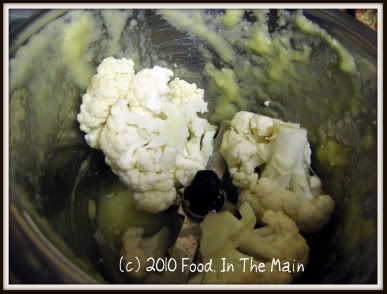
1/4 cup fresh pineapple puree
1 large egg
1 cup whole-wheat self-raising flour
1/4 cup powdered flaxseeds
1/2 tsp baking powder
1/2 tsp baking soda
2 tsp vanilla extract
15-20 skin-on almonds (toasted and chopped)
Method:
1. Heat oven to 180C/350F. Spray 12-cup muffin tray with non-stick spray or use silicone liners (which I sprayed anyway).
2. Mix brown sugar, flaxseed powder,
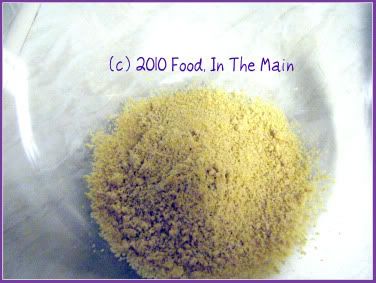
mashed banana, pineapple
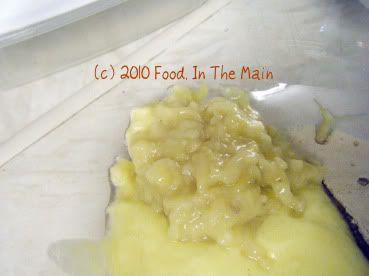
and cauliflower purees,
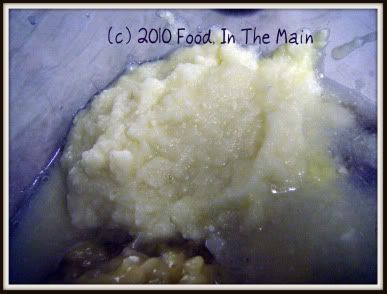
egg,
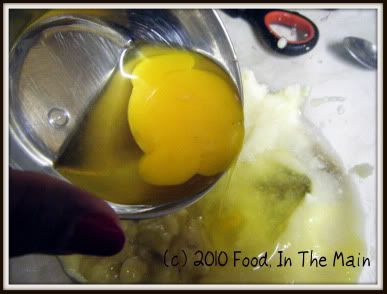
peanut butter,
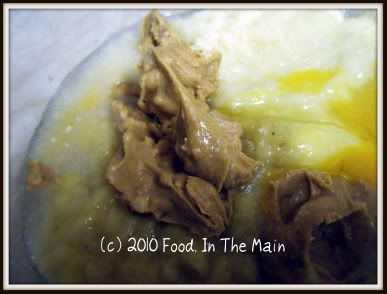
and vanilla extract. Mix well.
3. In a separate bowl, mix flour, baking power and baking soda.
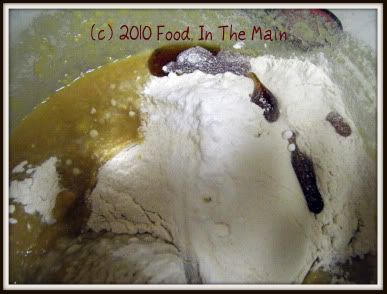
Pour into puree mixture, stirring just until mixed. The batter will be lumpy.
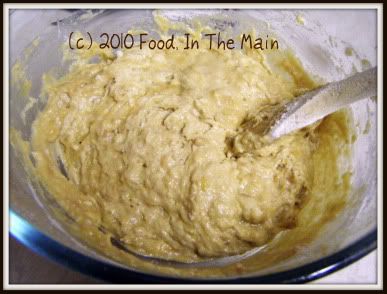
Lightly stir in the chopped toasted almonds.
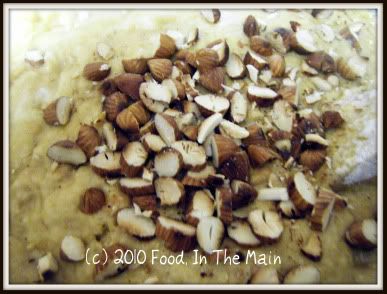
4. Divide batter into muffin cups and bake till the muffins are done (20 minutes or more, depending on your oven).
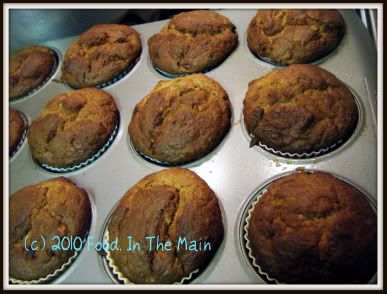
Test with a toothpick to check. Best served warm and fresh, but can be reheated to good effect in a microwave oven.
This is the third recipe using flaxseeds that I'm posting here in as many weeks... I haven't gone totally flaxseed crazy, honest. I do have other posts to write, and I have made other things (NOT using flaxseeds!) that need to be posted on my blog. But I'm still feeling an inexplicable antipathy to editing the darn photos, especially if there are lots of photos to choose from, and lots of photos to use with each recipe. Part of the problem is having to use a new photo editing tool (Picnik, free and online, which Nupur mentioned in a comment and which I latched on to quicker than quick) which seems slower than what I was using. Not that Picnik is difficult to use, it's just different... and yes, I'm just cribbing because I can... simbly only.
So yeah, before my solitary (but persistent) troll, who has cribbed before about the number and the quality of pics I use for each recipe, suggests that I use NO pix at all and thus resolve my anti-editing issues, I hasten to say that YES, that would be one solution. The other solution would be to perhaps cut down on the number of pics for each recipe... but I'm averse to doing that too. What I need is for someone to take over and kindly edit my photos. Actually what I need is someone who will take AND edit the photos, thereby hopefully making my blog a thing of beauty... but sadly that is not going to happen any time soon. *deep sigh* So until then I'm going to be posting recipes which have only a few instructions, and therefore only a few photos!
So, about today's recipe - the upma is really quite nice. But I'd probably powder the roasted flaxseeds next time, so as to release their aroma and flavour. (This is an older recipe than the previous one, and I hadn't discovered that powdered roasted flaxseeds are far superior in taste and aroma!)
PS. If you're wondering why there are no trolly comments to be seen on any of my posts, it's because I delete them. Not because they're critical of my efforts, but because the troll chooses to stay anonymous. I'll be damned if I let a coward take up any space on my blog.
Recipe for: Flaxseed aval/poha upma
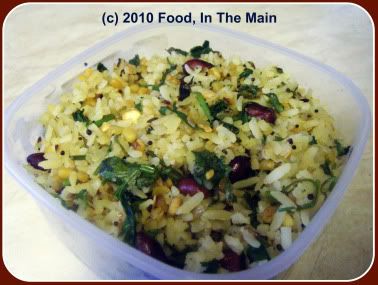
Ingredients:
1 cup aval/poha/beaten rice
2 tbsp golden flaxseeds/linseeds
1 tsp chana dal
1 tsp urad dal (I used whole)
1 medium onion, chopped finely
3-4 green chillies (or to taste), sliced finely
3 tsp oil
2 tbsp chopped coriander leaves
Handful of red peanuts with skin
salt to taste
lemon juice to taste
Method:
1. Soak the chana dal and urad dal in hot water for 15 minutes.
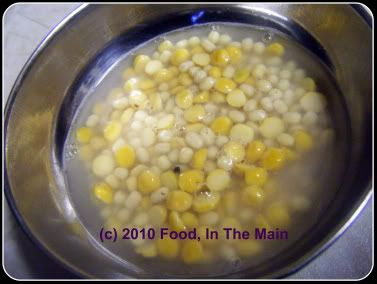
2. Rinse the aval/poha in water once or twice, sprinkle with 3-4 tbsp water and set aside covered so that the aval can absorb the water and rehydrate. The soaked aval/poha should be soft but not gooey or sticky.
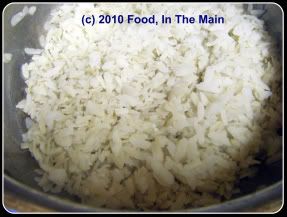
3. Heat 2 tsp oil in a pan and add the asafoetida powder, mustard seeds and green chillies. Cover the pan and let the mustard seeds pop. Add the chana and urad dals (drained), and fry them for 3-4 minutes. Then add the chopped onions and stir-fry till they are soft and cooked.
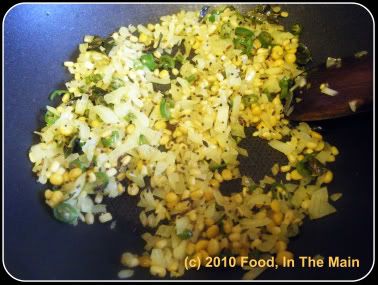
4. Add the soaked softened aval/poha to the pan and stir it in.
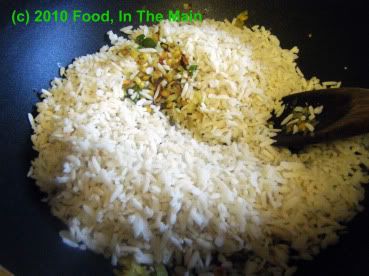
5. Add the dry-roasted linseeds/flaxseeds and mix that in as well, along with salt to taste.
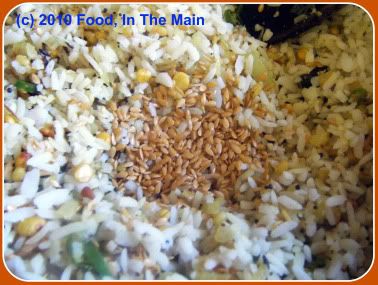
and the chopped coriander. Sprinkle lemon/lime juice to taste and mix it in.
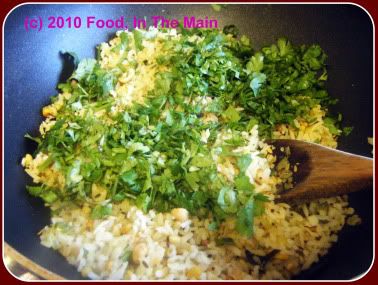
6. Fry the peanuts separately in the remaining tsp oil till they emit a nice aroma and the skin turns a shiny dark red. Scatter them over the poha and serve the finished upma for a snack or a light meal.
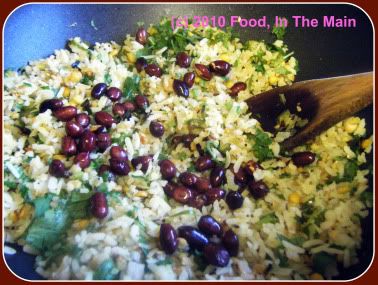
This is the recipe which changed my mind about the tasteworthiness of flaxseeds/linseeds and convinced me that these seeds have a permanent place in my kitchen.
I understand these seeds are chemically stable in seed form and keep well without going rancid, but flaxseed oil goes rancid quickly. What I don't know, however, is how long they keep after being roasted and powdered. But I figure that if you make this podi (powder) in small batches, it should get around any potential problems of rancidity.
Oh, and a cautionary note on the pack of flax seeds I bought: Please ensure that you drink at least 150ml water extra per tbsp of flax seeds you consume, as they can cause constipation (especially if you don't normally drink plenty of water in the course of your day, I guess). I should think, however, that if you use a tbsp - or even two - of the paruppu podi with rice for a single portion, the flax seeds should not interfere with the digestion because of the other ingredients that also go to make up the powder.
Try this podi mixed with hot cooked rice and a dollop of ghee... ahhh, heaven!
Recipe for: Flax seed/linseed paruppu podi
Ingredients:
1/4 cup tur dal
1/8 cup urad dal
1/8 cup chana dal
1/8 cup golden flax seeds
5-6 dried red chillies
3/4 tsp black peppercorns
1/4 tsp cumin seeds
10 fresh or frozen curry leaves
1/4 tsp asafoetida powder
Salt to taste
1. Dry roast the chana dal and tuvar dal together with the dried red chillies till they turn aromatic and pale golden brown and the red chillies are a darker shade.
2. Dry roast the urad dal, golden flax seeds, black pepper corns, curry leaves and cumin seeds till the seeds are golden brown and the curry leaves are crisp
3. Let all the dals and seeds cool completely, then grind to a powder that is the texture of fine sand. Add salt to taste and mix well. Store in a clean dry jar.
Why didn’t anybody tell me that linseeds (or flaxseeds, which is their other name) were so incredibly aromatic and tasty when roasted and powdered? All this while I’d been – well, not exactly put off by flaxseeds, but sort of avoiding them because they had this label of “health food”. The product information on the packs said I could add the seeds to salads or cereals or yogurt – none of which really appealed to me.
But I went ahead and bought a pack the other week, despite not quite knowing what to really do with the seeds. The first couple of times I added a tablespoon of the linseeds to my cereal, as per the suggestions on the pack. The seeds tasted ok, but I didn’t find them particularly moreish. Then I thought that perhaps roasting them would help – they tasted better, but there was no particular change in the aroma of the finished dish.
And then, while making a batch of paruppu podi, I decided to dry-roast some flaxseeds along with the dals and powder them. I knew that at the very least they wouldn’t add a nasty taste, and at best they would be an added health boost to a protein-rich powder. Again, no particular change in the aroma of the paruppu podi, not even when the dals and seeds were being milled into powder.
But when I had the podi with rice and a bit of ghee one night, I was completely surprised by the amazing taste! Yes, paruppu podi is an aromatic, tasty preparation, especially mixed with some ghee added to hot white rice... but this was something else again. I wasn’t entirely sure what I’d done for it to have the extra oomph, until I remembered the linseeds. Surely they couldn’t have been the reason?
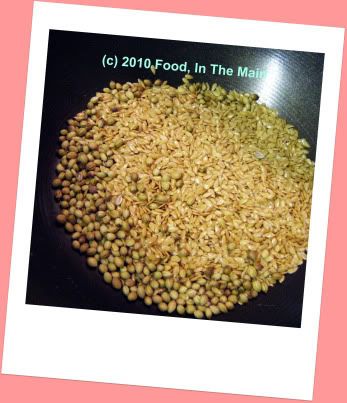
Of course I had to double-check this... so I roasted 3 tbsp of linseeds with 3 tbsp coriander seeds (and I would have roasted 2 tbsp urad dal with this, but I had store-bought roasted urad dal powder to use up) and cooled and powdered them.... and ohhh yeah! The linseeds finally came into their own, with a flavour reminiscent of roasted sesame seeds, but not as strong.
I made spiced rice with this powder for Pete and me that night to go with our special egg curry dinner, and he absolutely loved it.
A latecomer I might be to the delights of flax seeds, but now that I’m finally on board, it's going to be flaxseeds, flaxseeds all the way!
Recipe for: Flaxseed/linseed powder spiced rice
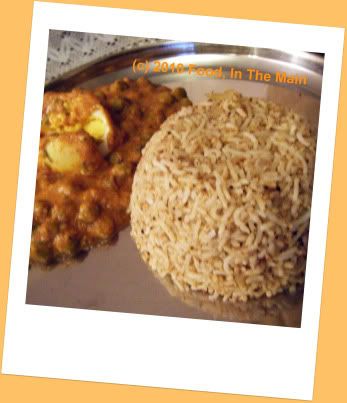
Ingredients:
3 tbsp coriander seeds
3 tbsp golden flax seeds
2 tbsp urad dal
2 dried red chillies (optional, or to taste)
1 medium onion, chopped fine
2 tsp mustard seeds
a few curry leaves (fresh or frozen)
1/4 tsp hing/asafoetida powder
Salt to taste
1 tbsp oil
4 cups cooked rice
Method:
1. On medium heat, dry roast the coriander seeds, urad dal, flax seeds and red chillies till the seeds are a darker shade and the urad dal is golden.
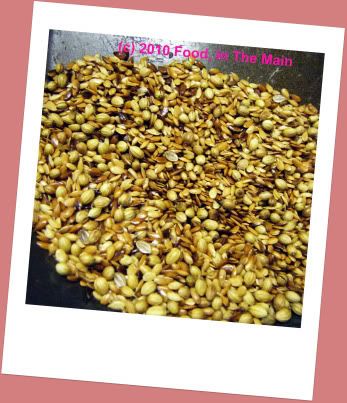
Cool and powder finely. (If you are using ready-bought roasted urad dal powder like I did, mix 2 tbsp of this after grinding the roasted coriander-flaxseeds).

Reserve.
2. Heat the oil in a large pan and add the asafoetida powder, mustard seeds and curry leaves. Cover the let the mustard seeds pop.
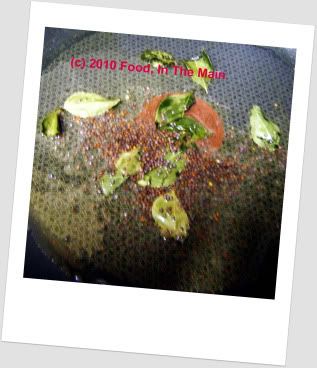
3. Add the finely chopped onions and fry them on med-low heat till they are translucent and soft.
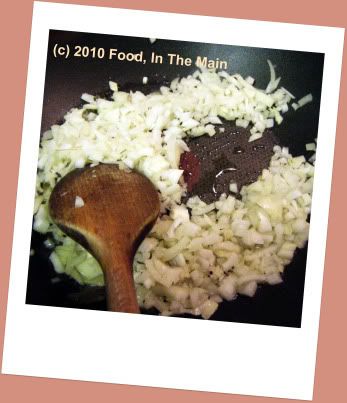
4. Add the cooked rice to the softened onions and mix it in carefully.
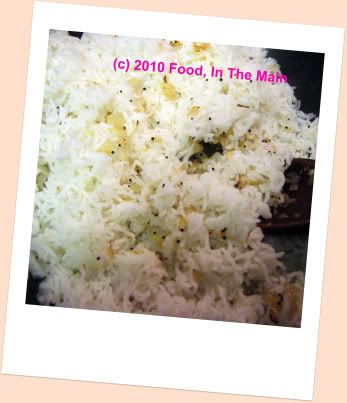
5. Now sprinkle 3 tbsp of the roasted flaxseed-coriander powder along with salt to taste on the rice
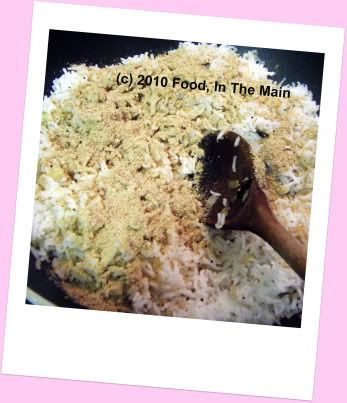
and mix till well amalgamated, taking care not to break the rice grains. Taste and check to see if more powder needs to be added.
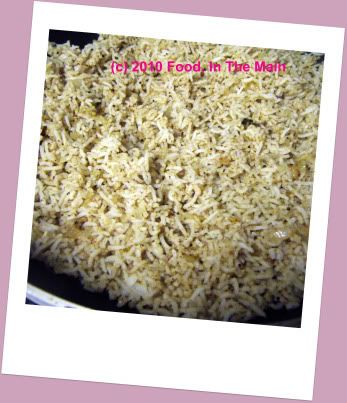
Make sure the rice is thoroughly heated, then serve hot with a gravy curry, or with a dry curry and a raita, or even by itself with something crunchy on the side.

















































